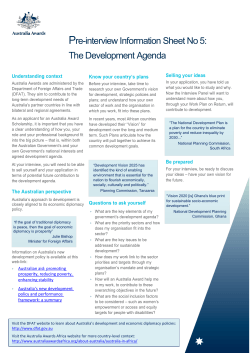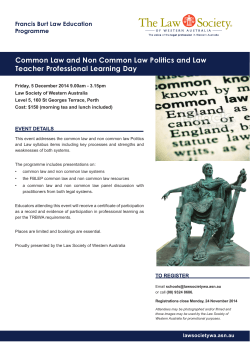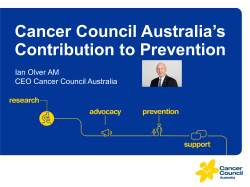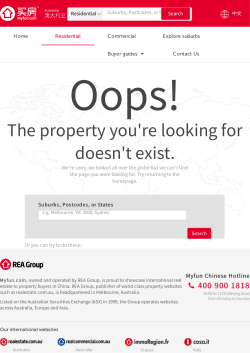
BSBWRT301A Write simple documents
BSBWRT301A Write simple documents Revision Number: 1 BSBWRT301A Write simple documents Date this document was generated: 5 June 2015 BSBWRT301A Write simple documents Modification History Not applicable. Unit Descriptor Unit descriptor This unit describes the performance outcomes, skills and knowledge required to plan, draft and review a basic document before writing the final version. No licensing, legislative, regulatory or certification requirements apply to this unit at the time of endorsement. Application of the Unit Application of the unit This unit applies to individuals who are skilled operators and apply a broad range of competencies in various work contexts. They may exercise discretion and judgement to produce a range of basic workplace documentation. Licensing/Regulatory Information Not applicable. Pre-Requisites Prerequisite units Approved © Commonwealth of Australia, 2015 Page 2 of 8 Innovation and Business Skills Australia BSBWRT301A Write simple documents Date this document was generated: 5 June 2015 Employability Skills Information Employability skills This unit contains employability skills. Elements and Performance Criteria Pre-Content Elements describe the essential outcomes of a unit of competency. Performance criteria describe the performance needed to demonstrate achievement of the element. Where bold italicised text is used, further information is detailed in the required skills and knowledge section and the range statement. Assessment of performance is to be consistent with the evidence guide. Elements and Performance Criteria ELEMENT 1. Plan document PERFORMANCE CRITERIA 1.1. Determine audience and purpose for the document 1.2. Determine format and structure 1.3. Establish key points for inclusion 1.4. Identify organisational requirements 1.5. Establish method of communication 1.6. Establish means of communication 2. Draft document 2.1. Develop draft document to communicate key points 2.2. Obtain and include any required additional information 3. Review document 3.1. Check draft for suitability of tone for audience, purpose, format and communication style 3.2. Check draft for readability, grammar, spelling, and sentence and paragraph construction 3.3. Check draft for sequencing and structure 3.4. Check draft to ensure it meets organisational requirements 3.5. Ensure draft is proofread, where appropriate, by supervisor or colleague 4. Write final document 4.1. Make and proofread necessary changes 4.2. Ensure document is sent to intended recipient 4.3. File copy of document in accordance with organisational policies and procedures Approved © Commonwealth of Australia, 2015 Page 3 of 8 Innovation and Business Skills Australia BSBWRT301A Write simple documents Date this document was generated: 5 June 2015 Required Skills and Knowledge REQUIRED SKILLS AND KNOWLEDGE This section describes the skills and knowledge required for this unit. Required skills literacy skills to read and understand a variety of texts; to prepare general information and papers according to target audience; and to proofread and edit documents to ensure clarity of meaning and conformity to organisational requirements problem-solving skills to determine document design and production processes. Required knowledge basic grammar, spelling and punctuation. communication protocols how audience, purpose and method of communication influence tone organisational policies and procedures for document production resources to assist in document production, such as dictionary, thesaurus, templates, style sheets. Approved © Commonwealth of Australia, 2015 Page 4 of 8 Innovation and Business Skills Australia BSBWRT301A Write simple documents Date this document was generated: 5 June 2015 Evidence Guide EVIDENCE GUIDE The Evidence Guide provides advice on assessment and must be read in conjunction with the performance criteria, required skills and knowledge, range statement and the Assessment Guidelines for the Training Package. Overview of assessment Critical aspects for assessment and evidence required to demonstrate competency in this unit Context of and specific resources for assessment Method of assessment Evidence of the following is essential: producing a range of documents that accurately convey required basic information using formatting suitable for intended audience knowledge of organisational policies and procedures for document production. Assessment must ensure: access to office equipment and resources examples of documents. A range of assessment methods should be used to assess practical skills and knowledge. The following examples are appropriate for this unit: direct questioning combined with review of portfolios of evidence and third party workplace reports of on-the-job performance by the candidate review of draft documents analysis of responses to case studies and scenarios demonstration of techniques oral or written questioning to assess knowledge of communication protocols review of final documents. Holistic assessment with other units relevant to the industry sector, workplace and job role is recommended, for example: Guidance information for assessment Approved © Commonwealth of Australia, 2015 BSBITU303ADesign and produce text documents other general administration units. Page 5 of 8 Innovation and Business Skills Australia BSBWRT301A Write simple documents Date this document was generated: 5 June 2015 Range Statement Approved © Commonwealth of Australia, 2015 Page 6 of 8 Innovation and Business Skills Australia BSBWRT301A Write simple documents Date this document was generated: 5 June 2015 RANGE STATEMENT The range statement relates to the unit of competency as a whole. It allows for different work environments and situations that may affect performance. Bold italicised wording, if used in the performance criteria, is detailed below. Essential operating conditions that may be present with training and assessment (depending on the work situation, needs of the candidate, accessibility of the item, and local industry and regional contexts) may also be included. Audience may include: Purpose may include: Format may include: Structure may include: Organisational requirements may include: Method of communication may include: Approved © Commonwealth of Australia, 2015 internal and external customers recipient/s who receive a copy for information primary recipient/s of the communication clarification of issues communication about meetings or events information minutes/outcomes of meetings request for information, advice or assistance statements of fact straightforward advice email forms letters memos minutes of meetings organisational templates or proformas for letters, memos or reports tables organisation of the material to suit the format (e.g. scannability for on-screen use) treatment of attachments and hyperlinks visual signposting of material, including use of headings, lists, keywords and text in boxes house style requirements identified authorities for signatories for correspondence/communications protocols, both written and unwritten for the organisation's internal and external communications requirements for inclusive and nondiscriminatory language and for adherence to copyright legislation inclusive communication use of active or passive voice use of the appropriate register or style of language - formal, standard or informal Page 7 of 8 Innovation and Business Skills Australia BSBWRT301A Write simple documents Date this document was generated: 5 June 2015 RANGE STATEMENT Means of communication may include: software packages such as MS Word, Excel, PageMaker, PowerPoint and templates Intended recipient may include: audience for document signatory of the document supervisor or other staff member who may add to or forward document to another recipient Unit Sector(s) Unit sector Competency field Competency field Communication - Writing Co-requisite units Co-requisite units Approved © Commonwealth of Australia, 2015 Page 8 of 8 Innovation and Business Skills Australia
© Copyright 2025









